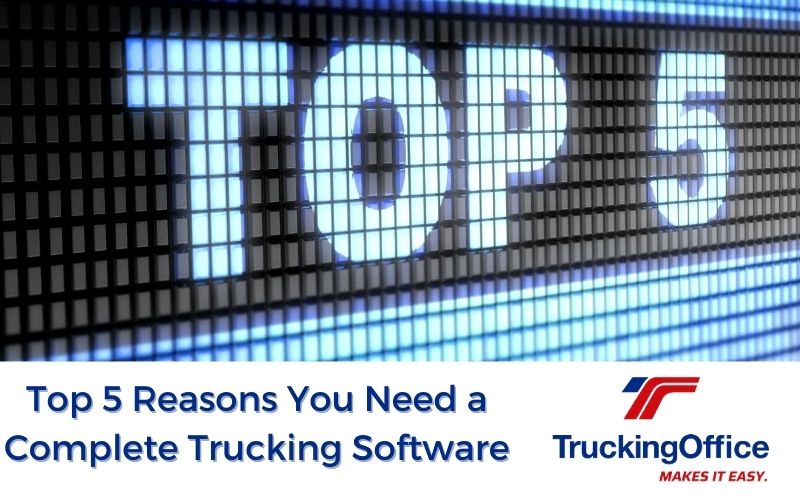As the trucking season ramps up, is it time to reconsider what software you use to run your trucking business? Because if you’re not using a complete trucking software package, you’re only hurting yourself.
What is a Complete Trucking Software?
We often see software packages for trucking companies. They offer a package that includes everything under the sun – except maybe no IFTA report, or no maintenance management, or no ELD.
No ELD? Do trucking management software programs have an ELD program?
Why not? Having an ELD that links directly to the trucking management software (TMS) makes sense. Accurate mileage reports and easy communications with drivers through an ELD app are only two reasons why a complete trucking software package should include an ELD.
Top 5 Reasons for a Complete Trucking Software
1 No mileage entry in IFTA report – collected by ELD for TMS
Do you remember to write down your mileage at state borders? With everything else that truckers have to remember, that’s one thing that often slips our minds as the miles slide by.
By using a complete trucking software that links with an ELD, those miles are automatically recorded. Every mile is accounted for – not just loaded miles. You don’t have to worry about forgetting miles for your IFTA report when you’re using a TMS and ELD together in one complete trucking software.
2 Accurate IFTA
Back when TruckingOffice first started, the programmers knew that an accurate IFTA report was a critical component of a trucking management software program. Back when we had to use multiple hard disks to upload programs (kids, ask your grandparents about those bad old days ☹️) TruckingOffice came on the market with a software package that used the data entered by the driver to produce an accurate IFTA report. No more did anyone have to spend hours at a desk trying to figure out how many miles had been driven in each state.
As TruckingOffice developed their TruckingOffice ELD, that task got even simpler with the GPS records. Now TruckingOffice’s IFTA report is accurate to the mile. Combined with our always up-to-date fuel tax rates per state or jurisdiction, those reports are available in seconds to show you how much you have to pay. No more guessing, no more wondering if you paid too much, or not enough.
3 Best Way to Communicate with Drivers
We never have trouble talking to drivers, do we? Of course not! Drivers are always ready and excited to tell us where they are at any given moment.
Ok, enough with the sarcasm. Reaching truckers is much easier now that we’ve got smartphones. But when brokers need information, smartphones might not be the best way to reach a driver. That’s why a complete trucking software package will include ways to get information from a driver about a load. And the next load.
Smartphones might be a great way to talk – but when it’s time to get that signed bill of lading, talk is worthless. A picture is worth a thousand words, and a picture of a signed BOL is worth whatever you’re getting paid for the load. Trucking software will allow the trucker to upload a picture of the signed BOL so that invoices can be sent out immediately.
4 Share Load/Trip Updates from Dispatch
Sometimes things about a load have to change. The broker provided the wrong delivery address. Scheduled delivery dates change. Emergencies on the road or detours that delay delivery. Communication between the driver, the home office, and the broker is
One benefit of a trucking software package is that ELD tracking allows you to prove how much time a trucker might claim for detention pay. The evidence from the ELD will show how long a truck stayed in the yard, waiting for the shipping crew to do their jobs.
5 Tracking Maintenance Tasks by Miles
Maintenance tasks require our attention in one of two ways: time or miles. To keep our rigs safe and on the road, we need to keep track of both. But tracking mileage isn’t like tracking time on a calendar. We can put a reminder on our calendars to check brakes or tire treads, but mileage is a much better gauge.
A complete trucking management system uses both time and miles to remind us of our maintenance tasks.
TruckingOffice PRO and ELD
Undoubtedly, having an ELD and TMS work together saves us time on the road and time in the office or on the phone. You’ll have better data to file your taxes and avoid the worry of doing your IFTA or IRP filing wrong. Your rig will stay in great condition as you keep your eyes on the maintenance tasks. TruckingOffice PRO and TruckingOffice ELD together make your trucking business successful!







Recent Comments